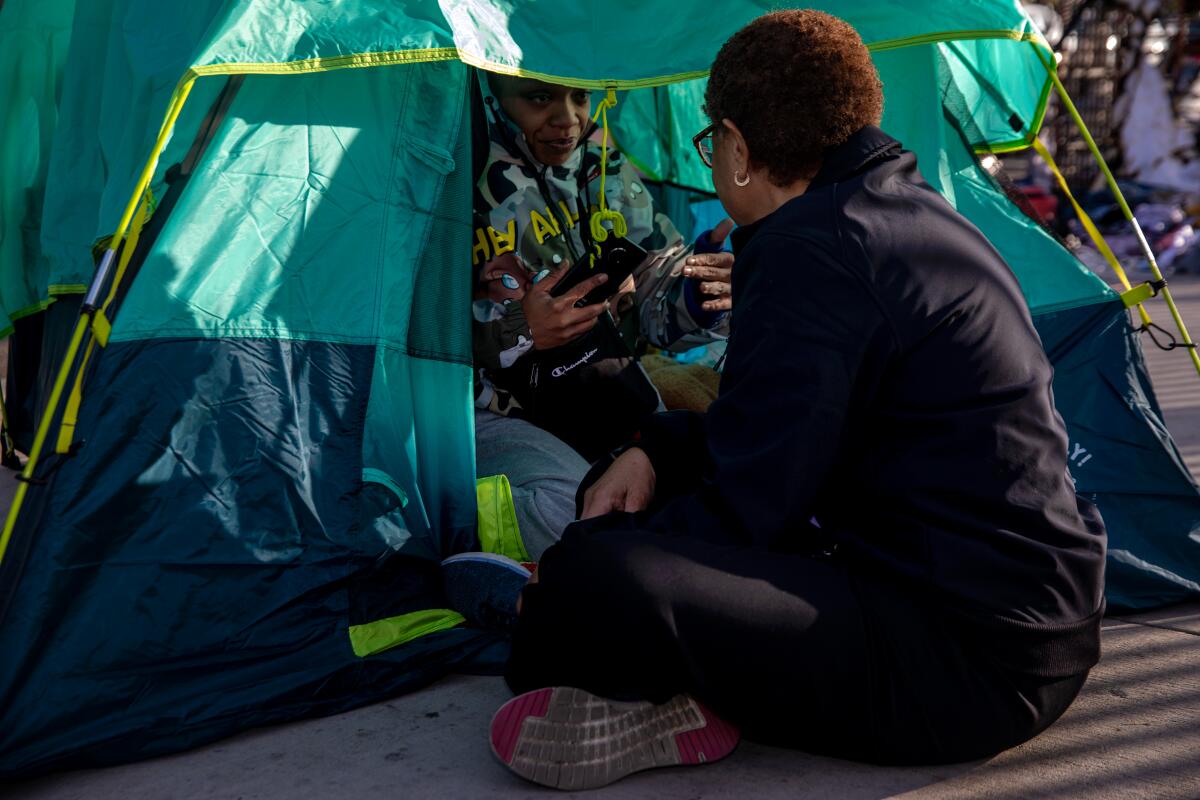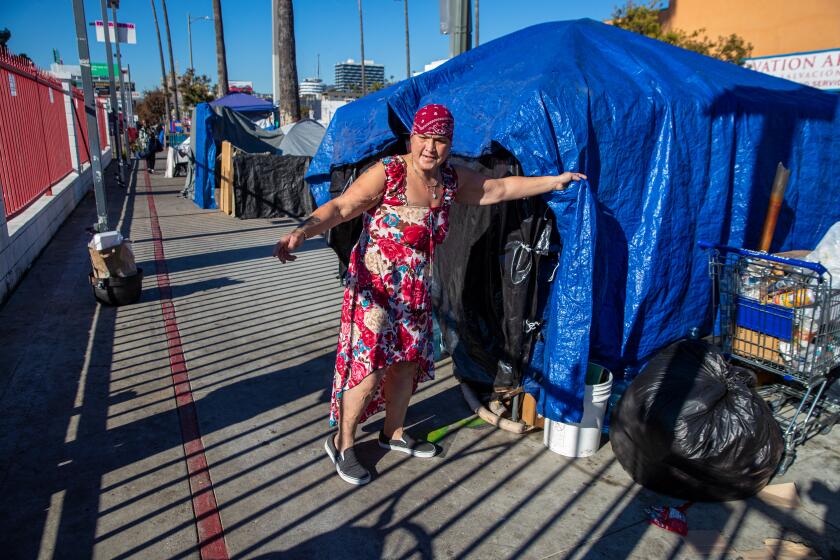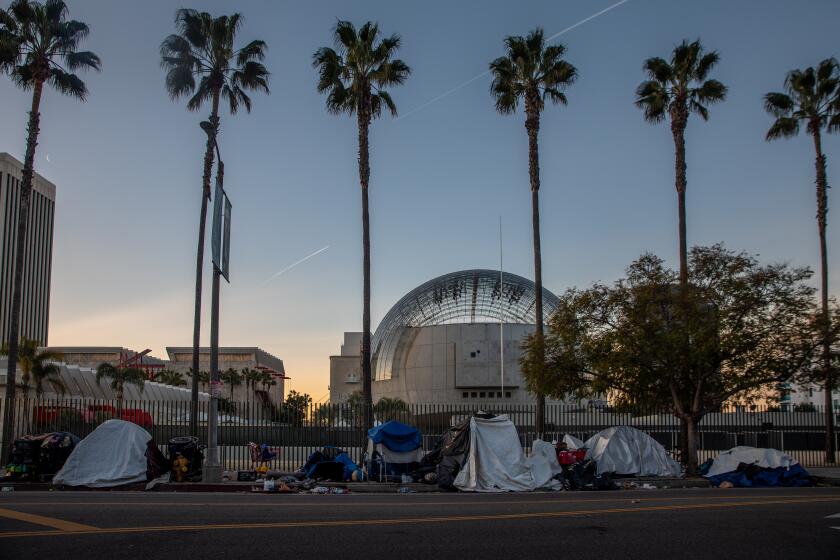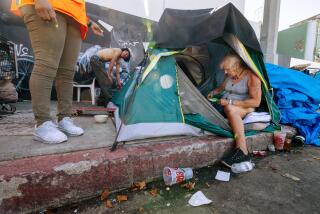Editorial: Mayor Bass didn’t end homelessness in her first 100 days. But she made a good start

Los Angeles Mayor Karen Bass came into office determined to tackle homelessness at full speed. She declared an emergency her first day on the job, ordered city agencies to fast-track reviews of affordable housing projects and launched Inside Safe, an ambitious initiative to move people from encampments into motels and hotels, then start them down a path to permanent housing.
As of last week, when she marked her 100th day as mayor, she had some impressive statistics to show. More than 1,000 homeless people, mostly from 13 encampments, have been moved into temporary housing, she says, and several homeless housing projects have been expedited.
The Inside Safe initiative has now made its way from the Westside to skid row and into South L.A. with the goal to reach across the whole city. In one case, Bass prioritized a large Venice encampment to forestall an enforcement action. “I wanted to demonstrate to the neighbors that there was a way we could deal with this without a law enforcement effort,” she told The Times Editorial Board last week.
If Bass and her staff can keep up this pace and speed up permanent housing projects, then the city could see a transformation on the streets.
There’s no question, after Bass got an earful on the campaign trail from residents angry over homeless encampments, that Inside Safe has been deployed into areas where residents seemed most aggrieved.
“We are trying to address the encampments where people are suffering the most who are both housed and unhoused,” she said. (Of course, it’s homeless people who are suffering. Housed people are typically just annoyed to see encampments on sidewalks.)
She says this approach is about housing people and showing residents that homeless people will accept such help when it is offered. “When neighbors are disillusioned and angry … and they haven’t seen a fundamental difference, then they say, ‘Forget it, arrest these people, take these people away, they’re all there because they choose to be there because they’re all strung out on meth.’ So what I’ve been trying to do over 100 days is really dispel that myth.”
Critics complain that some of the homeless people served by the mayor’s Inside Safe program have been shuffled from hotel to hotel.
Now the work gets even harder. It’s good to keep putting people in motels and hotels on a temporary basis. But there has been some shuffling of people from one motel to another — due to unlivable conditions (a roach infestation in one motel) and inadequate provision of services — which is unacceptable. People need to be able to settle in and focus on working with their case managers on getting into permanent housing.
More important, Bass needs to find more permanent housing faster. She says 62 people have moved through the Inside Safe program into permanent housing, and she knows that’s not enough. Bass must supply more housing through homeless housing projects coming online, through master leasing hotels or apartment buildings and through vouchers that people can use for rent on the open market — and finding an apartment in Los Angeles is hard for anyone, let alone a homeless person with a voucher worth a limited amount of money.
The point is: Housing is what makes homeless people no longer homeless. And rent on a small apartment is cheaper than putting people up in motels, as many service providers and homeless advocates say. So far, the City Council has shown Bass a lot of goodwill by dedicating $50 million to Inside Safe. And Bass says she has state funds at her disposal as well. But as more people move into motels and hotels, this effort will get costlier. By the 2022 count, there are 42,000 homeless people in the city.
Va Lecia Adams Kellum, the new head of the Los Angeles Homeless Services Authority, estimates the city is paying on average $100 a night for a motel room. That comes out to $3,000 a month, and doesn’t include food.
Bass says the city is helping supply more housing navigators, the people hired to help homeless individuals find available housing. And she is expecting to be able to streamline the process by which homeless people are selected and vetted for permanent housing to make the process go faster. All of that should help. Among the rental subsidies the city has been using are a few thousand short-term rental vouchers that were funded through emergency COVID federal dollars. That funding source stops in the fall. Bass needs to have a plan so that when the rental subsidies end, people with those vouchers don’t end up with no place to live.
Placing people in housing will be more challenging than placing people in motels and hotels — and that hasn’t been particularly easy. But if Bass keeps up the momentum she has demonstrated so far, then maybe the city really can help the poorest of the poor get the housing they deserve.
More to Read
A cure for the common opinion
Get thought-provoking perspectives with our weekly newsletter.
You may occasionally receive promotional content from the Los Angeles Times.











